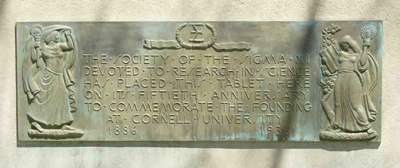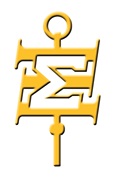Come Up Higher: The History of Sigma Xi
Friendship in Science. While those whose heart and soul is in their work, are coping with the great problems of Nature, let them remember that the ties of friendship cannot be investigated, but only felt. Let them join heart and hand, forming a brotherhood in Science and Engineering; thus promoting and encouraging by those strong, personal attachments of friendship, the highest and the truest advances in the scientific field. To lend aid and encouragement to those newer brothers, who likewise, laboring in the same sphere are aspiring to honored positions. And in collegiate halls to award an honor, which to scientific recipients shall signify, "Come up higher!"
Therefore, with these ends and objects, the signers of this paper, do hereby agree to lend their efforts to the establishment of an organization to be publicly known as the Society of the Sigma Xi.
From the first Sigma Xi Constitution (1886)

50 Year Commemorative Plaque at Cornell University
Sigma Xi was founded in 1886 at Cornell University  by a group of engineering students and a junior faculty member, Frank Van Vleck. From the beginning, the founders emphasized that the new scientific honor society would be broad in its outlook, devoted to all of science and engineering. Cornell geology professor Henry Shaler Williams soon became the fledgling society's chief mentor, serving as the first elected president and a leader of the growing organization until the turn of the century.
by a group of engineering students and a junior faculty member, Frank Van Vleck. From the beginning, the founders emphasized that the new scientific honor society would be broad in its outlook, devoted to all of science and engineering. Cornell geology professor Henry Shaler Williams soon became the fledgling society's chief mentor, serving as the first elected president and a leader of the growing organization until the turn of the century.
Sigma Xi was designed to reward excellence in scientific research and to encourage a sense of companionship and cooperation among scientists in all fields. In selecting a name and motto for the new honor society, the founders chose a combination of Greek letters--Sigma Xi--not being used by any other group. Later, a motto based on these initials was developed to confirm its purpose: Spoudon xynones, or "Companions in Zealous Research."
By 1887, Sigma Xi was holding "regular meetings for the discussion of scientific subjects," and the following year, the group elected five women to full membership, which both promoted the interests of women and made their research more available to the scientific community. By that time, chapters had been established at Rensselaer Polytechnic Institute, Union College, Stevens Institute of Technology, and Rutgers College, as well as at Cornell. Through the 1890s the Society's membership grew, and by the turn of the century Sigma Xi claimed more than 1,000 members in eight chapters.
In the first decade of the new century, chapters were added at the rate of one to three a year. Many adopted programs that went beyond scientific debate. None, perhaps, matched the importance of those supported by the Stanford and Berkeley chapters after the 1906 earthquake in San Francisco. At Stanford, a three-member engineering commission of Sigma Xi members oversaw reconstruction of the campus. The Berkeley Chapter publicized its concerns about public health in the devastated city of San Francisco, where rapidly breeding rats gave rise to cases of bubonic plague. The Berkeley Chapter led an eradication campaign, prodded public officials to action and raised funds. Few chapters have done more for their communities.
At its quarter-century anniversary in 1911, Sigma Xi had about 2,000 active members in 28 chapters. Two years later, former Sigma Xi president Samuel W. Williston urged the establishment of a "Quarterly Bulletin," which would, he argued, "create further interest in the Society and increase its usefulness." This publication would later become known as American Scientist, which today is a bimonthly, illustrated magazine that communicates the latest developments in science and technology across disciplinary lines.
As Sigma Xi grew, it came to play a prominent role in scientific affairs. In 1916, the newly-formed National Research Council asked Sigma Xi's "cooperation...in organizing...research facilities" in preparation for the country's expected entry into World War I, and the Society enthusiastically agreed. In the decade after the war, Sigma Xi experienced rapid growth, adding 26 new chapters. By 1927, Sigma Xi had firmly committed itself to a program (which continues today) of awarding small grants to young scientists through the Grants-in-Aid of Research Program to help advance their careers. By the end of the decade, Sigma Xi had about 9,000 members in 51 chapters and 22 clubs.
In the 1930s, 26 chapters were chartered, including important ones at Harvard, Princeton and the Massachusetts Institute of Technology. Society members at leading women's colleges like Smith, Bryn Mawr and Wellesley also established chapters. During this time the "promotion of research" was stressed, and many chapters adopted programs that demonstrated Sigma Xi's concern for younger scientists: awarding research prizes, offering fellowships, raising money to support Sigma Xi grants. As the Depression worsened, several chapters instituted loan funds for needy students.
Sigma Xi's Distinguished Lectureships Program, begun in the late 1930s, also supported the Society's outreach efforts and increased its visibility. The 1937 and 1938 Lectures appeared in print in a volume titled Science in Progress, edited by President George A. Baitsell, a Yale biologist. Reviews in the Saturday Review and the Christian Century noted how it conveyed "the surge of discovery" to nonscientific readers, a purpose that Science in Progress served in 15 subsequent volumes and is continued today by American Scientist magazine.
Sigma Xi chartered its 100th chapter in 1948, and by 1950, it boasted about 42,000 active members. In 1947, a group of Sigma Xi members formed the Scientific Research Society of America (RESA) to encourage research in government and industrial laboratories, in the same way that Sigma Xi encouraged research in the academic community. Throughout the 1950s and 1960s, Sigma Xi's growth continued unabated until it had more than doubled in size. Its influence also grew. In 1974, RESA merged with Sigma Xi, under the name of Sigma Xi, The Scientific Research Society of North America. A few years later, the present name was adopted: Sigma Xi, The Scientific Research Society.
Sigma Xi's Centennial in 1986 provided an opportunity to address issues of importance to science and society in the decades ahead. With support from the National Science Foundation, Sigma Xi sought to develop "A New Agenda for Science," a project that identified seven important areas for ongoing consideration: public understanding of science, science in the policy development process, interdisciplinary research, science education, the international dimension, cooperation-not competition-in science and technology, and ethical issues involving science and technology.
In response, Sigma Xi adopted an expanded mission statement in 1989: to honor scientific accomplishments, to encourage and to enhance the worldwide appreciation and support of original investigation in science and technology, and to foster worldwide a creative and dynamic interaction among science, technology and society.
Today, Sigma Xi has nearly 60,000 members in over 500 chapters in the U.S., Canada and other countries, including Switzerland, Thailand, Lebanon, New Zealand and Australia. Sigma Xi chapters are found wherever scientific research is undertaken in universities, colleges, industrial research facilities and government laboratories. Recent presidents of Sigma Xi have included Nobel laureate Frederick Robbins, National Medal of Science winner Kumar Patel, presidential science advisor Neal Lane, and National Science Foundation Director Rita Colwell (see Past Presidents of Sigma Xi).
For Further Reading...
See the September-October 1986 issue of American Scientist, which contains a review of Sigma Xi's distinguished history by Michael M. Sokal. The preceding history was based on Sokal's article